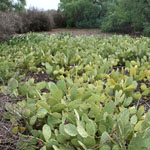Prickly pear (erect)
Common name:
- Prickly pear (erect)
Scientific name:
- Opuntia stricta Haw.
Plant status
Catchment management authority boundaries
Regionally prohibited in the West Gippsland catchment.
Regionally controlled in the Mallee, Wimmera, North Central, North East, Port Phillip and Western Port catchments.
Restricted in the Glenelg Hopkins, Corangamite, Goulburn Broken and East Gippsland catchments.
Plant biology
Appearance
Shrub (or bush)
Description
Prickly pear (erect) is an erect succulent shrub growing 1 to 2m high.
Stems
The stems of prickly pear (erect) are dull green or bluish-green, hairless and consisting of a series of fleshy segments (cladodes) each to 30cm long, 15cm wide and 1 to 2cm thick.
Each areole (potential growing point) contains tufts of short, very finely barbed bristles and occasionally, 1 to 2 stout yellow spines about 2 to 4cm long.
Leaves
Prickly pear (erect) has small, scale-like leaves produced beneath the areoles on young segments only and are shed as segments mature.
Flowers
Petals of flowers on prickly pear (erect) are lemon yellow with greenish or pinkish markings on the back. Flowers grow to about 6 to 8cm diameter and are sessile (stalkless).
Each flower has a fleshy base which becomes the fruit, borne mostly on the margins of the segments.
Fruit
The fruit of prickly pear (erect) has reddish-purple skin, reddish flesh and is somewhat pear-shaped. The fruit grows to 4 to 6cm long and bears tufts of fine barbed bristles in areoles.
Growth and lifecycle
Rate of growth and spread
Prickly pear (erect) reproduces by seed and from branch segments.
Local dispersal of the plant around existing clumps occurs when segments or fruit drop to the ground and take root.
Long distance dispersal of this weed occurs in a variety of ways. Droppings from birds, foxes and other animals aid in the dispersal of seeds in distances of over 1km.
Detached segments, as well as fruit, are carried by flood waters over long distances. Small segments and fruit of the prickly pear (erect) also attach to wool and hides of animals and to footwear and tyres of passing vehicles.
Human movement of plant parts, either through the promotion of this plant as an ornamental or hedge plant, or the disposal of it in rubbish tips and waste areas, is a major source of new infestations around urban areas.
Seedbank propagule persistence
Prickly pear (erect) contains numerous seeds in each fruit with the plant also producing numerous fruits. This weed has a long life span. Once established, individual plants can live for several decades.
Preferred habitat
The prickly pear (erect) prefers subhumid to semi-arid areas in warm temperate and subtropical regions. It grows mainly along streams and banks from where it encroaches onto adjoining grazing land.
Prickly pear (erect) invades lowland grassland and grassy woodland, dry sclerophyll forests, riparian and rocky outcrop vegetation.
The plant is drought resistant and does not burn easily.
Growth calendar
The icons on the following table represent the times of year for flowering, seeding, germination, the dormancy period of prickly pear (erect) and also the optimum time for treatment.
| Jan | Feb | Mar | Apr | May | Jun | Jul | Aug | Sep | Oct | Nov | Dec | |
|---|---|---|---|---|---|---|---|---|---|---|---|---|
| Flowering | ||||||||||||
| Seeding | ||||||||||||
| Germination | ||||||||||||
| Dormancy | ||||||||||||
| Treatment |
Impact
Impact on ecosystems and waterways
Prickly pear (erect) plays host to the fruit fly, providing a food source to a serious pest.
Patches of this weed also provide effective long-term harbour for pest animals such as rabbits.
Dense infestations of the plant could hinder access to water and reduce available fodder for fauna. The plant can also form impenetrable barriers. Stands can hinder growth of smaller shrubs and ground flora.
Agricultural and economic impacts
With its stout spines and bristles present year-round, the prickly pear (erect) is not usually grazed by stock, with most animals avoiding the plant.
The effect on quality of produce is unknown as the plant is not a weed of cropping or cultivated areas. It also has no impact on harvest costs and does not usually affect land prices.
Social value and health impacts
The barbed bristles of the prickly pear (erect) readily penetrate human skin and are difficult to remove, causing severe irritation.
Dense infestations of this weed can form an impenetrable barrier, posing as a high nuisance to people by restricting direct access.
Due to the spiny nature of the plant, it may affect some recreational activities. The root system is fibrous and shallow and unlikely to cause structural damage.
Management
Prescribed measures for the control of noxious weeds:
- cultivation
- physical removal.
Read about prescribed measures for the control of noxious weeds.
Other management techniques
Changes in land use practices and spread prevention may also support prickly pear (erect) management after implementing the prescribed measures.